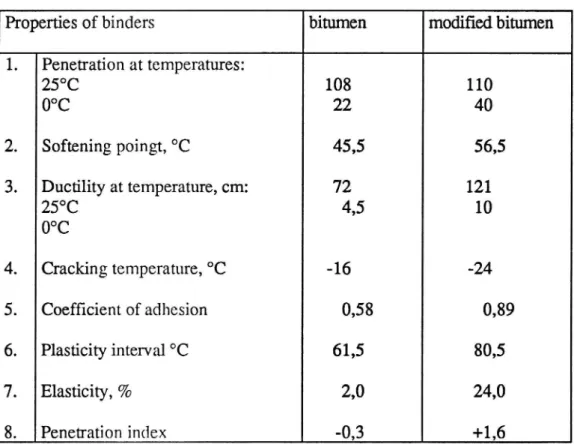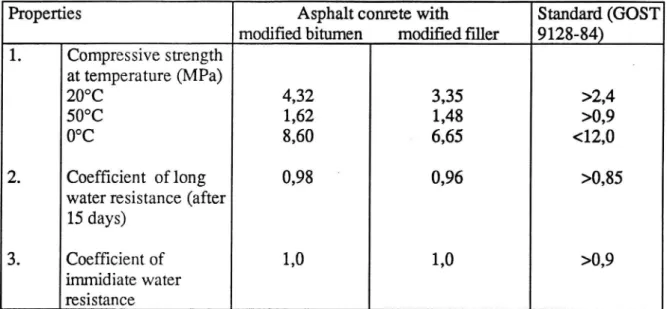VTl notat
Titel: Technical perspective on the production of asphalt concrete modified by the addition of rubber at the asphalt plant
Författare: Alexandre Akoulitch (gästforskare vid VTT, 1992-11-11 till 1993-08-10) och Alexej Busel
Avdelning: Projektnummer: Projektnamn: Uppdragsgivare: Distribution: Nr V221 1993 Vägavdelningen 47019-5
Gästforskare vid VTT från Vitryssland VTI Fri div
T
Väg-ochTrafik-WInstitutet
A.V.Akoulitch, A.V.Busel, The Eyelorussian Polytechnical Institute, Minsk
TECHNICAL PERSPECTIVE OF THE PRODUCTION OF ASPHALT CONCRETE; MODIFIED BY THE ADDITION
OF RUBBER AT THE ASPHALT PLANT.
SUMMARY
During the last years Byelorussian road industry has not had the opportunity to get a high quality grade bitumen and has had to use short residue (or residue bitumen). There are two techniques described in this paper. Both of them use waste crushed rubber to improve the asphalt concrete quality. In the first case, crushed rubber is addedduring the blowing of short residue. The processes of bitumen oxidation and bitumen modification are going
together. In the second case, the crushed rubber is placed
in a ball mill when preparing an activated filler. Milling conditions in the ball mill ensure most efficient destruction and active dispersion of the rubber. The above techniques thereby ensure an increase in the asphalt concrete shear modulus, resilient modulus and improve rutting and cracking
TECHNICAL PERSPECTIVE ON THE PRODUCTION OF ASPHALT
CONCRETE, MODIFIED BY THE ADDITION OF RUBBER AT THE
ASPHALT PLANT *)
A.V.Akoulitch A.V. Busel, The Byelorussion Polytechnical Institute, Minsk
Polymer waste materials are wider used in road construction. A considerable part
of research is devoted to implementing the use of crushed rubber, a product obtained from special treatment of used car tyres, in the asphalt concrete. Various techniques are used to produce the polymer modiñed asphalt, the most Widespread ones being thermomechanical treatment of the rubber in the presence of different plasticizers (waste materials from oil industry) [1]; termotreatment of the crushed rubber by asphalt at temperatures higher than 200°C; full thennodestruction of the crushed rubber by asphalt or short residue with subsequent blowing by air [2]; full destruction of crushed rubber in short residue and subsequent restoration of
resilient, elastic bonds by the addition of sulphur [4].
*) During the last years Byelorussian road industry has not had the opportunity to get a high quality having grade bitumen and has had to use short residue. The product is the heaviest fraction taken from the crude oil vacuum distillation process. The physical properties of the short residue may be modified by air blowing [6]. Almost all Byelorussian asphalt plants have a small equipment for air blowing in order to produce bitumen. The processed bitumen has rather low and variable quality and the authors of this paper try to ñnd ways to increase the quality of that bitumen
But no matter which method is used, thesetechniques are connected with the full or partial destruction of rubber. All the above techniques for the destruction of rubber involve a special technical operation not connected with the traditional production technique for bitumen and asphalt concrete. The techniques require supplementary equipment and thus increase energy consumption and working expenditure. The authors have suggested converting the crushed rubber into an asphalt mixture without completely changing the technical regime of the asphalt plant. Two solutions were found.
In the first case, crushed rubber (maximum size is about 1-2 mm) is added during the blowing of short residue when producing the bitumen in the asphalt plant. This technique includes the following operations:
The preparation of short residue (water removal and heating below a temperature of 180°C).
- Pneumatic transportation of crushed rubber into the prepared short residue,
mixed by paddle mixer and heated below a temperature of 210-220°C.
- Placing the resulting material in an oxidizer and blowing the short residue and crushed rubber together.
In order to accelerate the process of preparing asphalt modified by rubber, a
destruction initiator is used for rubber, together with oxidation catalyzer - mud
from polishing process of stainless steel (containing chromium) [3]. The properties of the bitumen modified by this technique are shown in Table 1. The results from analysis indicate a bitumen with higher termostability, improved deformation properties and adhesion to mineral materials, and an increased plasticity interval as well as elasticity interval. When using the oxidation catalyzer, the oxidation time decreases by 10-15 %. The asphalt concrete obtained with this modified binder has improved rutting and cracking stability. It has also high resistance to stripping, improved rheological properties and fatigue Characteristics. The physical and mechanical properties of the asphalt concrete are shown in Table 2.
In the second case, the crushed rubber is placed in a ball mill when preparing an activated filler. Milling conditions in the ball mill (intensive mechanical influence and high temperature) ensure active dispersing and destruction of the rubber. The
temperature of the mineral material passing through the ball mill is 120-150°C. In
consequence of this, the rubber is heated to 80-100°C, corresponding to the
minimum energy required for rubber destruction [4]. Moreover, a surface active substance, a caprolactam, is put into the ball mill to initiate destruction of the rubber [5]. During milling, the fresh mineral surface of the ñller interacts with chemically active free radicals and groups of the milling rubber, thereby ensuring a
physical-chemical activation of the ñller. The mineral-rubber ñller thus obtained is
placed in the asphalt mixer where asphalt concrete is prepared. Use of the
mineral-rubber ñller allows improvement of the strength and deformation properties of the asphalt concrete (Table 2). The above technique thereby ensures an increase in the shear modulus of a factor of three at loading speeds corresponding to the dynamic influence of the traffic. The resilient modulus of asphalt concretes increased on average by a factor of two at testing temperatures of 0°C and 20°C.
A number of experimental sections were laid on Byelorussian roads by highway construction companies. These experiments have shown that the new asphalt concretes are highly stable under environmental and traffic load influence.
The above techniques of using crushed rubber in asphalt concrete make the best use of the positive qualities of rubber - elasticity and the sufñciently high adhesion to mineral materials - thereby ensuring maximal positive effect.
Table 1. Properties of polymer-modiñed binder
Properties of binders bitumen modified bitumen 1. Penetration at temperatures: 25°C 108 110 O°C 22 40 2. Softening poingt, °C 45,5 56,5 3. Ductility at temperature, cm: 72 121 25°C 4,5 10 0°C 4. Cracking temperature, °C -16 -24 5. Coefñcient of adhesion 0,58 0,89 6. Plasticity interval °C 61,5 80,5 7. Elasticity, % 2,0 24,0 8. Penetration index -0,3 +1,6
Table 2. Properties of asphalt concretes
Properties
Asphalt conrete with
Standard (GOST
modified bitumen modiñed ñller 9128-84) 1. Compressive strength at temperature (MPa) 20°C 4,32 3,35 >2,4 50°C 1,62 1,48 >0,9 0°C 8,60 6,65 <12,0 2. Coefñcient of long 0,98 0,96 >0,85
water resistance (after 15 days)
3. Coefñcient of 1,0 1,0 >0,9
immidiate water resistance
Reference
1. Rudenskaja I.M., Rudenskij A.V. The organic binders for road construction.
Moskva, 1984.
2. Patent of Great Britain, n 1539116.
3. Patent of USSR, n 1595813.
4. The using of waste polymers materials. Moskva, 1985.
5. Patent of USSR, n 1611896.

